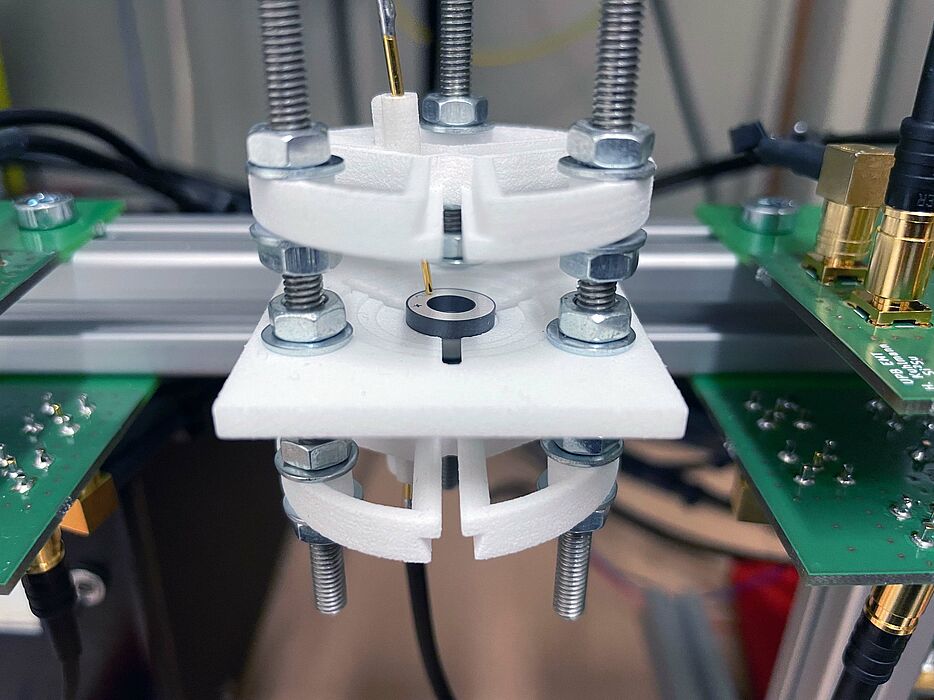Paderborn research group NEPTUN receives DFG funding
Today, ultrasound is widely used in science, technology and medicine. Power transducers – i.e. the elements that convert electrical signals into mechanical movements – are increasingly being designed and optimised with the aid of computers in what is known as a ‘CAD process’. While computer technology and simulation software have reached a high level of performance, insufficient knowledge of accurate material data for the components used in the design process is currently proving a major problem. The ‘Model-based determination of non-linear properties of piezoceramics for power transducer applications’ (NEPTUN) research group, led by Professor Bernd Henning of the Faculty of Computer Science, Electrical Engineering and Mathematics at Paderborn University, is aiming to solve this problem by developing standardisable model-based methods for determining complete and consistent material parameter sets. The researchers have now received funding for their project from the German Research Foundation (DFG) to the tune of just under €1.7 million for the first 4-year funding period. Other members of the research group are Professor Jens Förstner (Theoretical Electrical Engineering), Dr Tobias Hemsel (Dynamics and Mechatronics) and Professor Michael Winkler (Partial Differential Equations) from Paderborn University and Professor Andrea Walther and Dr Benjamin Jurgelucks (Mathematical Optimisation) from Humboldt University Berlin.
Ultrasonic applications in which high power is introduced into a medium are referred to as ‘power transducer applications’. High-power ultrasound is used for cleaning spectacles and drilling hard, brittle materials, as well as in electronics manufacturing, for example. It is also widely used – and these days indispensable – in medical technology: in scalpels and for dental scaling and kidney stone fragmentation. Today, ‘piezoceramic materials’ are commonly used to generate and detect high-power ultrasound. Due to the piezoelectric effect, these ceramics deform when an electrical voltage is applied. This enables them to convert electrical signals into mechanical energy or movement. The high power levels in these applications place tremendous stress on the materials used. “The combination of mechanical, electrical and thermal stress means that we need to better understand these phenomena and the way they interact and to characterise material properties as a whole,” explains Professor Bernd Henning, Head of the Measurement Engineering Group.
To avoid the material-intensive and time-consuming production of prototypes for ultrasonic sensors and actuators in the future, computer-aided simulation tools are being increasingly used in the design process. However, these simulations can only deliver realistic results if accurate material data is used. And this is where the problem lies: Based on the state of the art, individual piezoceramic material properties and parameters are in each case determined on the basis of different samples that are specially processed in different ways, with the result that the material parameters are inconsistent and only partially represent the properties of the piezoceramic component that is then actually used. “There’s also the fact that there’s currently no suitable mathematical model for power transducer applications that can be used to describe, in particular, the non-linear behaviour of piezoceramic materials with sufficient accuracy,” continues Henning.
The NEPTUN research group now wants to develop universal methods to analyse the behaviour of any given piezoceramic and to characterise design-relevant material properties. To this end, it is working on realistic mathematical modelling and a multi-physical simulation environment, while at the same developing robust measurement methods and systems to simultaneously record the electrical, mechanical and thermal properties of piezoceramic materials using a single sample. Finally, the group plans to devise a model-based methodology for determining complete and consistent material datasets for piezoelectric materials and characterising piezoelectric components for power transducer applications holistically.
“This objective is particularly important due to the fact that lead-based piezoceramic materials are currently still almost exclusively being used in power transducer applications, even though a special license is required to use them. As materials are usually selected based on the properties derived from the material parameters, sufficiently precise characterisation is also crucial because of the necessary alternatives. SMEs in the industry in particular stand to benefit from this new characterisation method when converting piezoelectric materials,” concludes Henning.


